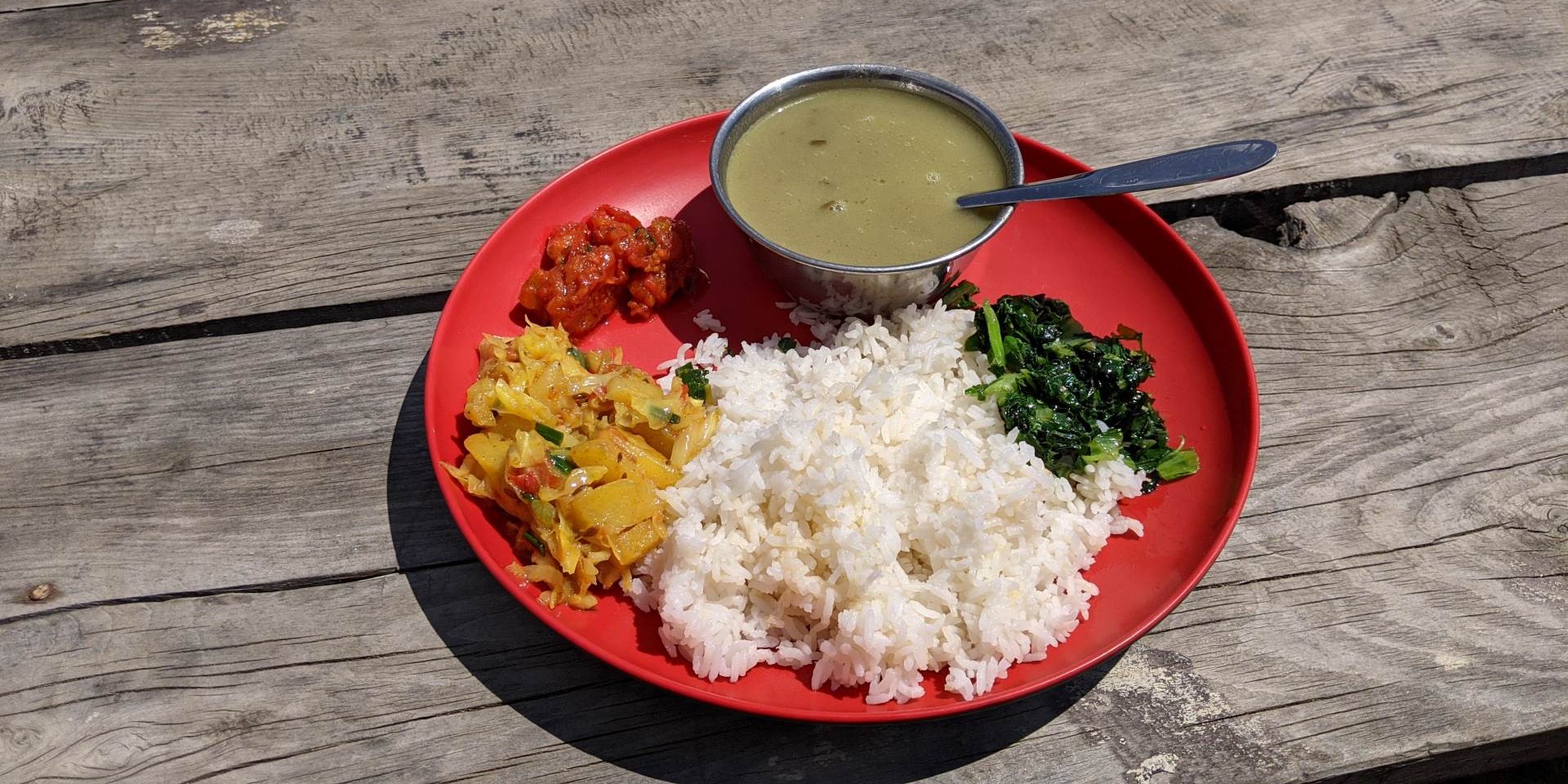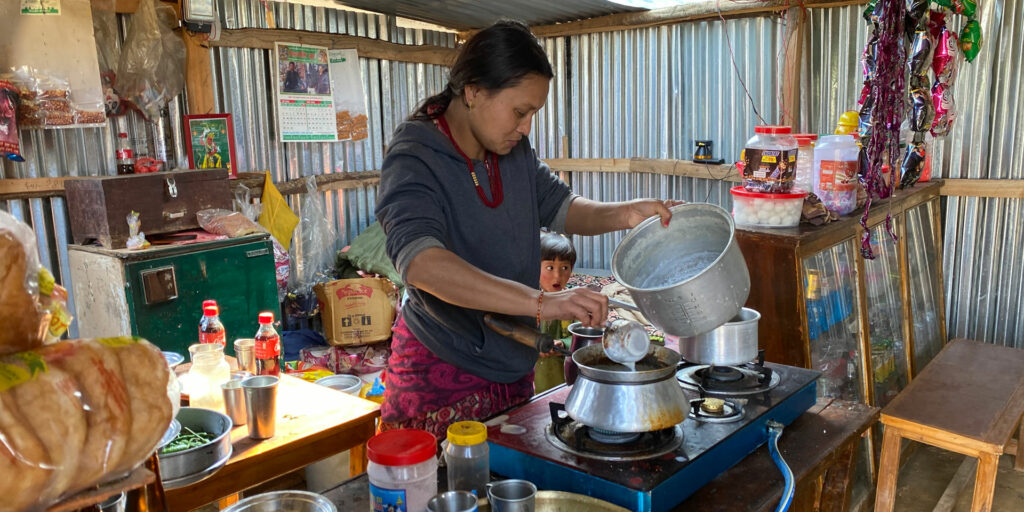Blog
Food and Meals While Trekking in Nepal
The snow-capped mountain views, Nepali hospitality and the meals that you eat are all part of the incredible experience of trekking in the Himalayas.
Here’s a deep dive into the flavours, traditions, and practicalities of eating while trekking in Nepal.
The Staple: Dal Bhat Power, 24-Hour
The phrase “Dal Bhat Power, 24-Hour” is a mantra among trekkers and locals alike. Dal Bhat is the cornerstone of Nepali cuisine and consists of steamed rice (bhat) served with lentil soup (dal), complemented by seasonal vegetables, pickles, and sometimes meat. This dish is a nutritional powerhouse, offering the perfect balance of carbohydrates, protein, and fiber—ideal fuel for long days on the trail. One of its best features? Unlimited refills in many teahouses, ensuring you’ll never go hungry.

Teahouse Menus: A Blend of Tradition and Convenience
Teahouses are the lifeline of trekking in Nepal. These simple lodges dot the trails and offer a place to sleep and eat. Getting a freshly cooked, hot meal along the trail is certainly a welcome luxury! Their menus are surprisingly diverse, with options ranging from traditional Nepali fare to international comfort foods.
Besides dal bhat you’ll often find dishes like:
Momos: Steamed or fried dumplings stuffed with vegetables and/or meat served with a tangy dipping sauce.
Thukpa: A hearty noodle soup that’s perfect for colder, higher altitudes.
Fried Rice or Noodles: Simple yet satisfying, often made with eggs and vegetables.
- Pizza and Pasta: The usuals that you're familiar with, expect them to come with a Nepali twist
Pancakes and Porridge: Breakfast staples that provide a warm, carb-rich start to the day for maximum energy.
- Breads: Fried Tibetan bread is a great choice for breakfast, as is chapati that pairs particularly well with a fried egg/omelette. They're always freshly hand made!
Unique Regional Delicacies
Trekking routes in Nepal often pass through regions with distinct culinary traditions. For instance:
In the Annapurna Region: You might encounter apple orchards, leading to fresh apple pie being added to the menu.
In the Everest Region: Sherpa stew, a thick soup made with vegetables, potatoes, and noodles, is a local specialty. Potatoes are particularly good in this area and you'll often see items like potato pancakes on the menu and fries/chips are really tasty!
In the Langtang Region: Try yak cheese, a rich and creamy product made from the milk of yaks grazing in the high pastures.
High-Altitude Adjustments
As you climb higher, your body’s energy demands increase, and your appetite might fluctuate due to the lower oxygen levels. Many trekkers find solace in carb-heavy meals like pasta, potatoes, and bread. At higher elevations, the menus might become more limited due to the limited availability of ingredients (or there may not be a menu at all), and dishes take longer to prepare due to the lower boiling point of water. Patience is key, but the wait is often rewarded with warm, nourishing food. Fueling your body is imperative, even if your appetite isn't huge.
Hydration and Snacks: Staying Energized
Staying hydrated is crucial at high altitudes, and teahouses offer plenty of options. Ginger tea, milky Nepali tea, and hot lemon are popular choices, helping to keep you warm and refreshed.
Please carry capacity for at least 2 litres of water, our guides are equipped with Katadyn water filters to provide you with fresh drinking water. Either water bottles or hydration bladders work well, but remember that hydration bladders can easily freeze in cold temperatures at altitude so do bring along a bottle as well, it's also in important backup in case your bladder springs a leak!
For snacks along the trail, biscuits and chocolates are readily available for purchase. If there's something in particular you like to nibble on while walking, do bring it from Kathmandu. There's a wide range of nuts, dried fruit and locally produced (and very tasty!) energy bars.
The Role of Food in Cultural Exchange
Sharing meals in Nepal is more than just about eating; it’s a way to connect with locals and fellow trekkers. Sitting around a communal table in the tea house dining room, swapping stories over steaming plates of dal bhat or sipping tea by a fire, is a quintessential part of the trekking experience. Many teahouse owners take pride in their cooking. You'll often see them pop out the back door of the kitchen to their vegetable garden to pick the greens to accompany meals. Talk about local sourcing!
Eating sustainably
Go local: The most sustainable way to eat while trekking is to eat what everyone else is eating... dal bhat! It's tasty, nutritious and packed with energy!
Buying snacks in Kathmandu, rather than bringing them from home will save a LOT of food miles.
Packaging: Be mindful that packaging needs to then be disposed of, which is limited in the Himalayas. Consider packing your waste out with you, bringing snacks that avoid too much packaging and think about the packaging that food has come in, for example, the plastic around a packet of pasta or the glass/plastic of a beer/soda bottle.
Wastage: The food you're eating is mostly carried in by porters and resources are all limited in the mountains (fuel, water, electricity, manpower) so please don't waste food.
Communal dining: You may like to order the same meals as your fellow trekkers or choose a few different dishes that you'll all eat, which allows the tea house to reduce their fuel usage and saves water because there's less washing up.
Practical Tips for Eating on the Trail
Stick to Cooked Foods: To minimize the risk of foodborne illnesses, prioritise cooked dishes over raw items like salads.
Go Vegetarian: Meat is harder to source and store at higher altitudes, so vegetarian options are often fresher and safer. Your guide will always be around the kitchen to ensure that hygiene standards meet our expectations and they'll let you know if there's something you shouldn't order. If the kitchen is extra busy, they'll jump in to lend a hand, too.
Wash, wash, wash your hands: Hygiene is imperative and hand hygiene is one of the biggest reasons people get sick while trekking in Nepal. Always wash your hands well with soap and water for at least 20 seconds. Remember that there may be doorways and surfaces you touch on your way into the dining room so even if you've just washed your hands, apply hand sanitiser before eating. Because even if your hands are clean, you can't guarantee that the people who touched the same door as you washed their hands properly.
Comfort Treks
If you've booked a trek with comfort accommodation (sometimes referred to as luxury lodges), they'll provide a set menu for each meal with multiple courses.
Let us know if you have any dietary requirements or preferences and we'll let you know how we can accommodate it.
Camping Treks
Most of our treks use the local tea house accommodation which is great for not only supporting families and small businesses out in the villages, it's also super convenient to show up and have everything we need waiting there for us!
Some treks require camping in locations where tea houses are not available. Our camping crew brings along all the equipment needed for camping, including the kitchen where they'll prepare hot meals 3 times per day. Our full-service camping meals are a combination of Nepali and international dishes, the crew has even perfected camping pizza!
For shorter stints away from tea houses, expedition style camping is possible. We keep it simple with basic meals (think noodle soup or backpacking style freeze-dried meals) that get us through the few days before we're back to the relative luxury of a tea house.
Dietary Requirements and Preferences
Let us know what dietary requirements and preferences you have, no matter what type of trek you're doing. We've never come across a diet that we cannot accommodate, but we do need to know in advance so that we can prepare the trekking crew and even possibly make some alternate arrangements for you.
Dietary requirements for medical reasons as well as preferences because of likes/dislikes are accommodated.
Bon Appetit
The food you eat while trekking in Nepal is more than just fuel; it’s a reflection of the landscapes, cultures, and communities that make the Himalayas so special. Embrace the simplicity, savor the flavors, and let each meal become a cherished part of your adventure. We are fortunate to have people along the way (often living in tough conditions) to allow our adventures to happen!



